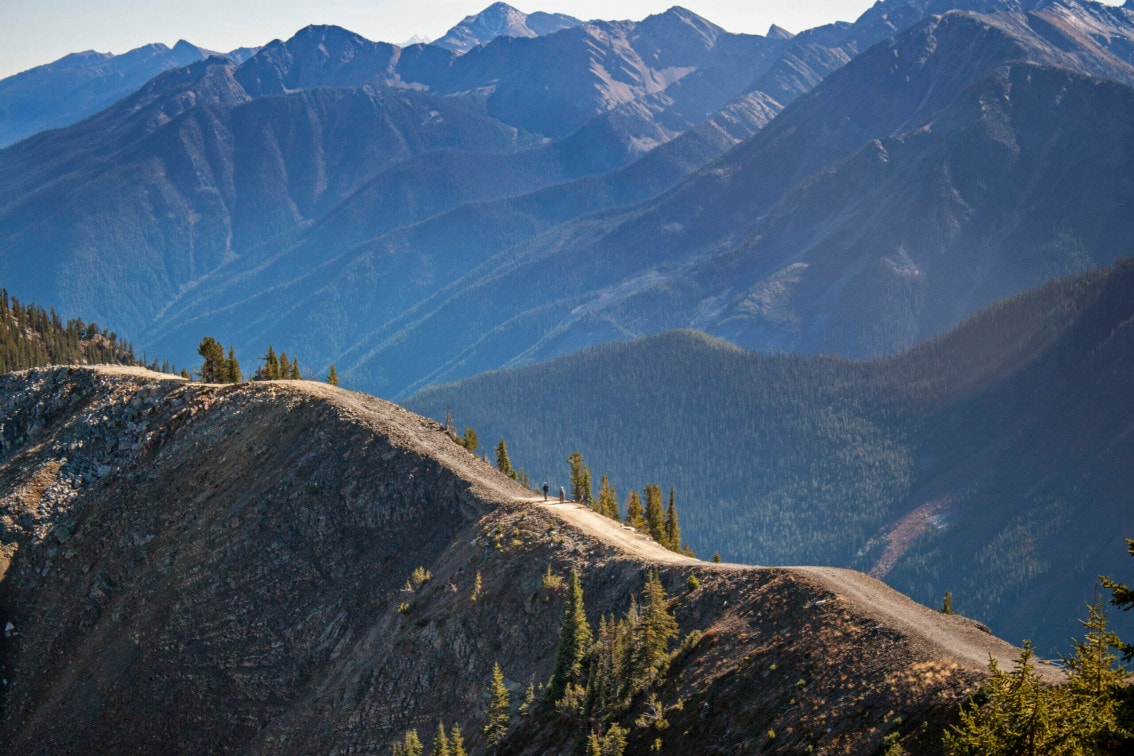
Day 1
Leg One: Nelson to Cranbrook
Autumn: my favourite time of year for a road trip.
It still looked largely like summer on the West Kootenay side. But here, after rounding the pass from West Kootenay to East, the leaves burst into a vibrant spectrum that ranged from summer’s green to deep red.
Autumn: my favourite time of year for a road trip. Nature dressed in jewel tones, perfect outdoor temps, snow dusting the peaks; though the Kootenays demonstrate the ideal of each season, it’s fall that wins my heart.
And with the flavours of fall making a reappearance, it’s also not a bad time to mix in a tour of the Kootenay craft beer scene.
This combo is exactly what we’ve set our sights on.
Sitting in the passenger side is my boyfriend and trip navigator, Brent. A Kootenay native, he’s been working with beer for a few years now, planning and starting his own brewery back in Nelson. Keen to experience East Kootenay craft beer and meet the founders, he’s come along as my “guinea pig” to talk — and taste — beer.
It’s a trip that wouldn’t require much arm twisting to get a road trip partner for.
Then there’s me: a girl who lived for three years in her car, seeking the depths of local cultures, local foods, and adventure landscapes. If there’s a snowy mountain or a river flowing fast, I want to be there — preferably with the promise of some from-scratch dining at the tail end of the adventure. I traded four wheels for four walls in the region I thought would best serve my wandering wishes: the Kootenays.
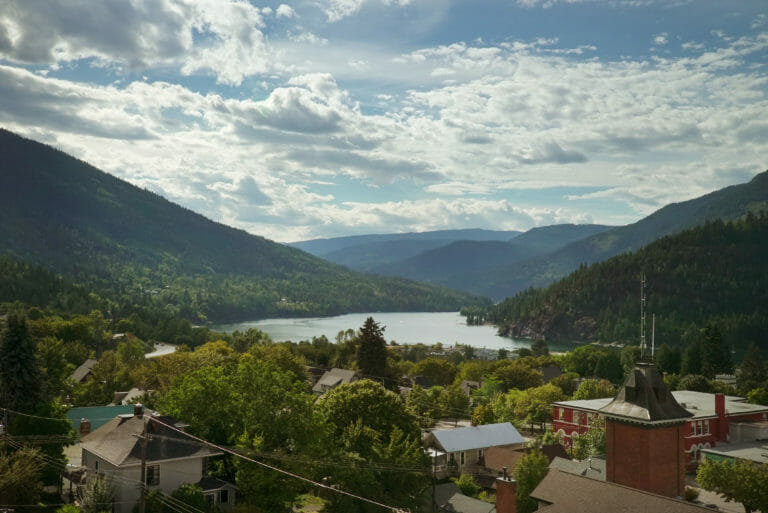
Back on the road, Brent and I wind through the wetlands of Creston, where the Kootenay River widens into marshland, before we take on the Purcells. For most of our trip until we hit Revelstoke, this range will remain to our west with the Rockies framing our road trip’s eastern boundary.
As we near Cranbrook, our destination for the evening’s stay, it’s the Rockies that have me glued to the windshield. The tips of the range are hued in purple except for one peak. Rising 300 metres in prominence above the others and decked in coral pink is Fisher Peak, the highest peak in the southern Canadian Rockies. It’s said that when you stand at the summit, a hiker’s view reaches two provinces and three states. It’s a view that Cranbrook’s own NHL legend, Scott Niedermayer, thought was deserving of the Stanley Cup, so he lugged it to the summit during his champion day with the trophy.
Even from my windshield perspective, the peak and its surrounding summits are so captivating in their sunset colours that the sight apparently overwhelms my auditory ability; I miss Brent’s directions for our hotel.
Backtracking, the road pushes us through a landscape of pine forest, scrubby undergrowth, and grasses. We follow the curves of Mission Road, unaware that its name is a hint of history that references our lodging for the night. The adjacent hillsides fall away from the road and, there in a valley, I spot it: an early 20th-century, multi-storied stone building with a long, manicured entrance.
Grand.
I pull in, excited to see the interior. From researching Kootenay golf courses earlier this year, I knew the name of the hotel — St. Eugene — as it related to its golf course. When it was completed, it was named in the top three for Golf Digest’s picks of Canada’s new courses, giving it a place in glossy magazine media.
But I refer to the earlier hint that Mission Road had provided. Entering the lobby, I am faced with paintings, historic photos, and quotes, all of and from Ktunaxa members, the First Nations people of the Kootenays. The building where I am standing wasn’t originally created for hotel guests to come and go as they pleased; it was originally part of the “Oblate Order” mission, created as a residential school for the Ktunaxa children.
“Since it was within the St. Eugene Mission School that the culture of the Kootenay Indian was taken away, it should be within that building that it is returned.” – Elder Mary Paul, 1984
Thus reads a quote accompanying a painting of an elderly woman. I assume it depicts Elder Mary Paul, and I marvel at the strength of the statement and of the Ktunaxa people in using this building to demonstrate their tenacity of spirit. I walk the halls to my room, my fingers tracing the bricks, imagining the halls filled with children who were now either my parents’ age or long passed on.
Stepping into our room, I take a moment to appreciate the classic styling and clean layout and look forward to sleeping on the overstuffed bed. We drop our bags, flip out the lights and re-enter the car, retracing Mission Road back to the centre of Cranbrook.

I’d only remembered to grab a tangerine for Brent and I to split while on the road, so I’m ready to chow down. The Heid Out Restaurant and Brewhouse was first on the itinerary. Lucky for us: Its reputation as a great Cranbrook eatery had preceded our visit.
I duck the car under the “Cranbrook” archway that spans the main entry to downtown, then spot the warm light spilling out from the glass windows of The Heid Out. The light acts as a beacon against the contrasting twilight colours deepening in the sky, guiding these two hungry travellers. I look for a parking spot in the front row so we can get inside and in front of a menu in rapid fashion.
But it’s busy. In fact, the place is hopping: chatter is loud, patrons are dressed in their weekend finest, the mood is jovial. In line behind me, a local informs me that this is the spot to hang out. From the lack of available chairs in what is already a large seating area, I can tell.
Before the waitress seats us, I take a glance at the beer menu, written on a colourful chalkboard directly across from the front entry. The selections come from Fisher Peak Brewing Company, the local brewery named after that stunning peak I saw just hours before. Started by Jordan Aasland, co-owner of The Heid Out along with Heidi Romich, the majority of the brewery dominates the lower level of the restaurant’s building, creating an entire in-house, family-owned operation.
Seven Red Seal Chefs outfit the kitchen, creating food using Kootenay ingredients when possible. The team’s culinary prowess is complemented on the brewery side by both Jordan and his partner, Mark Simpson, who brings brewing know-how from his time with Coors, Granville Island Brewing, Kirin, Lowenbrau, and Molson.
We’re seated and handed a diverse menu that’s filled with comfort food favourites from North America and beyond. Along with his späetzle dinner, Brent orders tasters of all six styles that Fisher Peak has on tap. I choose the chicken masala after hearing that one of their chefs brought his family recipe over from India. I’m a sucker for anything that comes with a story.
Hockey and soccer play-by-plays are airing on screens around the dining area, and patrons — along with Brent — are keeping a close eye. Cheers and groans intermingle with conversation, filling the room with a steady hum.
I turn to the oversized vintage posters and historic photos on display underneath a ceiling of wooden beams and exposed pipes. The area’s legendary stories, such as “The Great Elephant Hunt” of 1926 — when about a dozen visiting circus elephants decided to make their escape — decorate the walls. This story also inspires one of the brewery’s beers on tap: the Elephant Run IPA.
Somehow, I get the feeling I’d like these owners.

And then one appears. Heidi takes a seat at our table, introduces herself, and I take the opportunity to dive into conversation. Amongst other things, she relates an interesting tidbit about the discovery of a beer recipe from the 1800s: The instructions were complete with all but one ingredient legible, so with some creative liberty, Fisher Peak recreated the farmhouse ale. Staying as true to the original as possible, including aging it naturally and using no preservatives, it’s now making an annual appearance during the town’s annual “Sam Steele Days” and at the nearby heritage town, Fort Steele.
We’re still talking when the food arrives, but she excuses herself with the promise of a brewery tour once we’re ready.
Brent and I steal bites off each other’s plates and are equally impressed, enough that we order dessert, though we’re already stuffed. With bellies full of masala, späetzle, craft beer, and chocolate-dipped pretzels, I leave Brent at the table to find Heidi and cash in on her promised tour. She leads me downstairs to show off the conditioning, fermentation, and serving tanks, as well as a super-hero figure they keep around as a mascot.
The latter is a little testament to the easy-going nature I’m discovering. It’s clear from how Heidi talks that she’s deeply invested in the business, not only as an owner, but as someone who cares about her family, staff, and larger community.
As I re-enter the dining area to join Brent, a horde of men move toward us. Stars must have aligned for our visit: it coincides with the first-ever, beer-ladened, Cranbrook Fall Festival. The men, representing three breweries from East Kootenay, had just wrapped up an evening of slinging beer to hundreds of attendees, and hearing about two travellers visiting on a beer-themed road trip, they join our table.
The evening goes on for several more hours with lots of craft beer talk and banter. And, of course, with several additional rounds of beer.
I dive under the covers as soon as we return to our room at St. Eugene. I’m exhausted, looking forward to the next day’s plans, and ready to dream away in the massive bed.
Fisher Peak Brewing Company Beer Picks
Grapefruit Radler: ABV 3% • IBU 6
Blended with their Belgian Wit, this radler has a light, refreshing taste, with a playful smell that hearkens back to my childhood.
Dark Stormy Porter: ABV 5.5% • IBU 34
Thick, warm, rich, and comforting. The smell is of raisin, but the taste is of chocolate. On a fall or winter night, this is the combo you’d want.
I’m up early to get some writing done, but as I move aside the curtains to check out the view, writing falls by the wayside. The sun isn’t up yet, but the landscape is awash in pre-dawn light; steam rises from the pool, and the roof — reminiscent of colonial Spanish-tiled roofs — contrasts with the green of the golf course, tipped with dew, beyond. But the feature of this view is a section of foot hill beyond. As if heaven is directing a spotlight, the sun’s golden light shines hits just a section where a slice of earth is cut away. Here, revealed in the interior layer of the foothills, hoodoos appear to be taking shape.
I watch the sun’s movement from this window for the thirty minutes or so. The cool blues disappear and the staff at St. Eugene begin to work on the grounds, indicating to me that it’s time to tear myself from the window and get ready for our day. Writing will have to wait.
We roll our bags from our room in departure. Smells from the buffet meet me at the lobby, making my stomach roar. I look at Brent with questioning eyes. I know we need to get on the road, but the chefs are inviting me with smiling eyes behind their buffet stations. Time is pressing, though, and wins. After paying a compliment to the delicious aromas surrounding me, I ask one of the chefs about any cafes or places to get a quick bite en route to Fort Steele, where we’re headed for the morning.
“Oh, if you can wait, you should eat there,” says one. “They have a great bakery that produces everything from scratch using a big, wood-fired oven.”
Sold.
Nearing the Kootenay River, which sits at the foot of Fort Steele, the banks crowd the sides of the highway and frame my view. My attention is forced onto Fisher Peak again, this time because it’s framed by the terrain I’m driving through. It’s just as stunning in full daylight.
With the Kootenay below and that mountain scenery above, I have a sneaking suspicion that it wasn’t just the draw of a gold strike that initially brought settlers here. I imagine myself being one of those early-day pioneers. “Smart people, those folks,” I think.
Brent and I walk into the building that guards the entrance into this heritage town. Its false-front facade proclaims “1898,” the year that the town claimed itself as a bustling little economic centre: 11 hotels, four restaurants, four general stores, a hardware store, tailor shops were just a few of the businesses Fort Steele held within its boundaries.
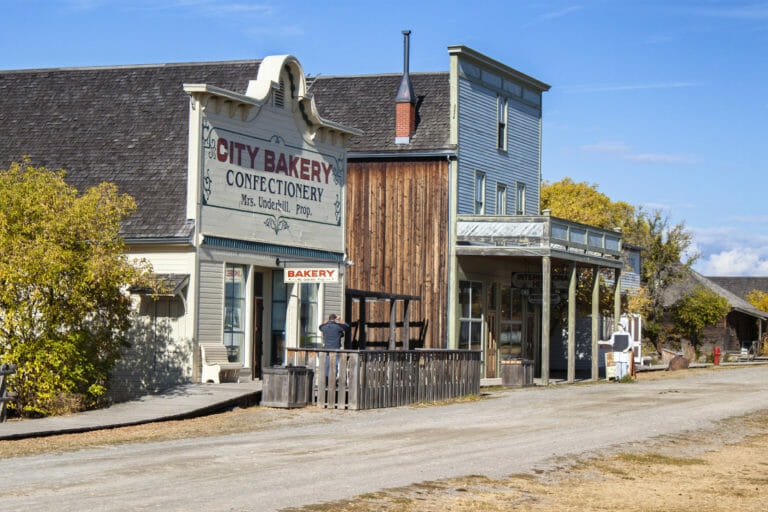
But the building holds more significance to our trip: It is in 1898 that the building was constructed, and within it, the Fort Steele Brewery. Now housing a shop, ticket desk, and a little eatery, a few artifacts still remain to pay tribute to the building’s brewing past.
We also know that once inside the town, there’s a drinkable tribute to this brewery: Fort Steele Mountain Ale, the farmhouse beer recreated from the historic recipe at Fisher Peaks Brewing Company.
Though obviously built in years gone by, the buildings and grounds at Fort Steele look as though they are still being lived in and used. Tradespeople work leather and bake bread, others are fixing the plaster on a log cabins using a traditional mixture of clay, lime, sand and even horse manure. Most of the buildings are open to walk through, still with furnishings and knick knacks. It’s all so present feeling that I half expect the school bell to ring and children to return to their lessons scrawled across the board.
Brent and I enter the bakery, where we’re greeted by a young man and woman in period dress. I want to eat everything. Instead, I place an order at adjoining hotel for a plate of ribs while Brent picks up a pastry and cup of coffee. While waiting for my breakfast — which by this time is also lunch — back in the bakery, the workers tell me about their daily tasks, which include chopping wood each day to heat the massive brick oven behind them.
It being off-season for the town, the chef, Robert, personally delivers my plate of ribs — so big that both Brent and I decide to split the meal — and has a chat with us about our trip. We talk about visiting Fisher Peak the night before and hearing the tale of the historic farmhouse ale. He excuses himself for a few minutes, then returns with two chilled “Fort Steele” mugs filled with a golden liquid and creamy head.
The Mountain Ale!
Drinking a piece of history — brewed just the same way with the same ingredients — in the midst of this heritage town feels about as close to living the past as I can expect to get in this lifetime. The crisp refreshment cuts the richness of the barbecue ribs, the sun takes just enough of the chill out of the fall air, and Brent and I are happy.
Day 2
Leg Two: Cranbrook to Fernie
Back on the road, we’re headed to my first Kootenay love: Fernie.
This is the place where I first entered the Powder Highway; it’s the place where, five years ago, I stood in the midst of town, staring up at the Lizard Range, and nearly dropped my bags for good.
I’m giddy as we approach. Our visit here combines three great elements: culture, mountains, and our fill of food and beverage. At the Mount Broadwood pulloff, just east of the tunnel on Crowsnest Highway, I get out to let the view expand from my windshield to 360-degree views. A boulder in the parking lot begs to be climbed for better views. In two moves, I’m at the top, looking at valley crisscrossed by the Elk River, two fly fisherman casting gossamer lines through the sunshine, and fall colours punctuating the green mountain wall behind it all.
I sigh. Another moment of perfection.
We travel on, weaving with the Elk River until we hit Fernie’s downtown. It’s small, but aside from the few buildings that made inroads in the later part of the 20th century, it’s consistently beautiful in its historic authenticity. Rows of two- and three-storey brick buildings, mostly from the first decade of the 1900s, stand like a movie set and encircled by the Lizard Range. The shops range from bike shops to letterpress to a traditional chocolate maker to a delicious favourite of mine: Big Bang Bagels.
We’re still full from the pile of ribs we ate clean at Fort Steele so instead of perfect bagels, we’re off just kiddy-corner to learn the backstory of this tiny town I nearly called home.
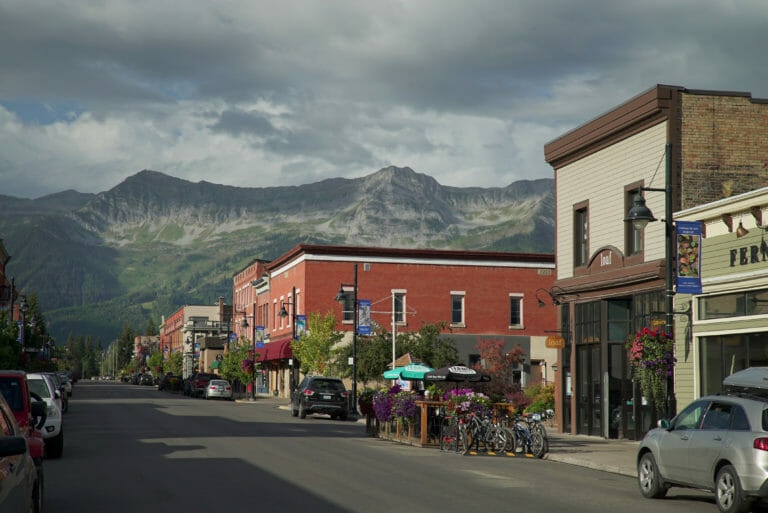
The Fernie Museum piles interactive displays and themed areas into a contemporary, compact space. It manages to feel well-designed and bursting at the seams at the same time. Artifacts here are meant to be touched, stories use spoken word, and the town’s tragic past are told in equal parts with the triumphs.
One of the first displays conveys an interesting contrast to where we are as modern mountain lovers: “The Ktunaxa people gave the Elk Valley [where Fernie is located] a wide berth, naming it ‘A Bad Place’ because of its thick forest, uncrossable rivers and heavy snowfalls” — all aspects that Fernie now celebrates and uses to draw in visitors from around the world.
While pondering the contrast, I mentally slip into the times before modern recreation, when both the European and Ktunaxa people lived lives of forced practicality focused on survival.
I’m drawn to the “Fernie Faces” display. Placing an earpiece against my ear, I choose to listen to “Annie Balayti,” an immigrant who arrived in Fernie as a little girl in 1898. She believed she was coming to a promised land, but at the time of her arrival, it was mostly mud and miners. “The only certainty,” the voice portraying Annie says in my ear, “was that the forest went to the edge of the peaks and the peaks went to the sky.”
Over 100 years later, I really can’t describe Fernie any better than Annie did when she first arrived here.
I learn about the fires that ripped twice through town, destroying the homes and downtown core that sprung up after Annie’s arrival. The second fire, which took only 90 minutes to level the entire town in 1908, sparked a city requirement that the town be rebuilt with fire-retardant materials. The result is what I see standing today: turn of the 20th century, rose-coloured brick buildings lining downtown Fernie.
Eventually, the value of those heavy snows and timbered lands transformed from burdens to important aspects for those living in a mining town: “Residents worked hard to create a town they could take pride in, building rinks, parks, swimming pools and ski hills, allowing people to forget the day-to-day stresses of living in a coal mining town,” reads a display describing the “work hard, play hard” ethic of Fernie.
Thus, recreation was born for this mountain town.
After an hour of interacting with the museum’s exhibits and one-way conversations with “Fernie Faces,” I turn around one last time, planning to give my thanks to the museum staff and head out. There, on the floor near the entry — completely missed by me — are old wooden barrels stamped with “Fort Steele Br’g Co – Fernie.” Two worlds collide: the history of a bygone boom town melding with a town still alive and thriving, both brought together in their earliest days via the industry of beer.
Turns out, the Fort Steele Brewing Company, just two years after opening their brewery under the gaze of Fisher Peak, had the foresight to see Fernie as a town with more future. They removed their headquarters from Fort Steele, transferring production to a newly built, state-of-the-art facility in view of the Lizard Range. Written within the Free Press, Fernie’s original newspaper, dated from 1902:
“The brewery is one of the largest in British Columbia; in it is found every modern improvement for the production of lager beer and porter and the goods are being sold all over East Kootenay and Alberta … The cooling plant was installed by the Buffalo Refrigerator Co. and does away with the use of ice. The water supply .. is taken fresh and pure and in any quantity direct from the never failing springs of the Rocky Mountains.”
From this description, I’m humoured by how far we’ve come (at least with explaining technology) and at the same time, how close we’ve stayed to our roots, such as proudly proclaiming the use of pure Rocky Mountain water as the base for beverages.
With that segue, Brent and I are off to Fernie Brewing Co.
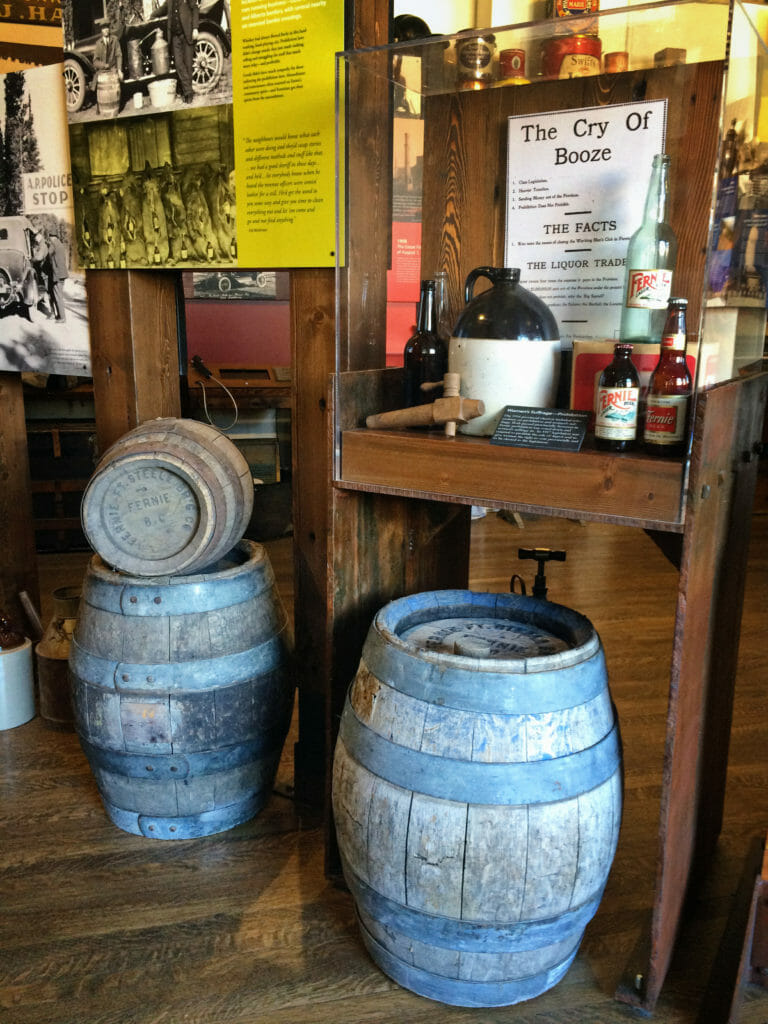
The brewery sits just east of town in a building feels partly like a modern take on barn, with a roof’s pitch mirroring the mountain slope behind it. I imagine both must be intentional: built in 2007, the current building was designed after the owners decided to expand from their original location in the family barn — and this place just seems like the kind of place that the designer would take details like landscape into account.
Intentional design or not, the building is cool. We walk through the doors and right off the bat, I notice the open sitting space filled with natural light pouring in from floor-to-ceiling windows. Lit coolers with colourful labels and a “Cheers to Charity” message adorns the entry wall.
I turn the corner and come face-to-face with everything Fernie Brewing Co: Plaid shirts, toques and mountainscape-embellished trucker caps, black- and turquoise-coloured opaque growlers — even pajama pants — fill the wood-lined wall. It’s clear that the brewery has their branding on point. These items aren’t just a logo slapped on a token item; each is something that was created to become a favourite piece to wear or own, from the artwork to the style.
But we’re here for the beer, and the bar becomes the focus. The branding extends to their tap handles, with different colours on each matching the bottle and can labels I spotted in the cooler. Twelve of them stand ready for pulling a fresh glass, so Brent and I take a seat; we’ll be tasting for a while.
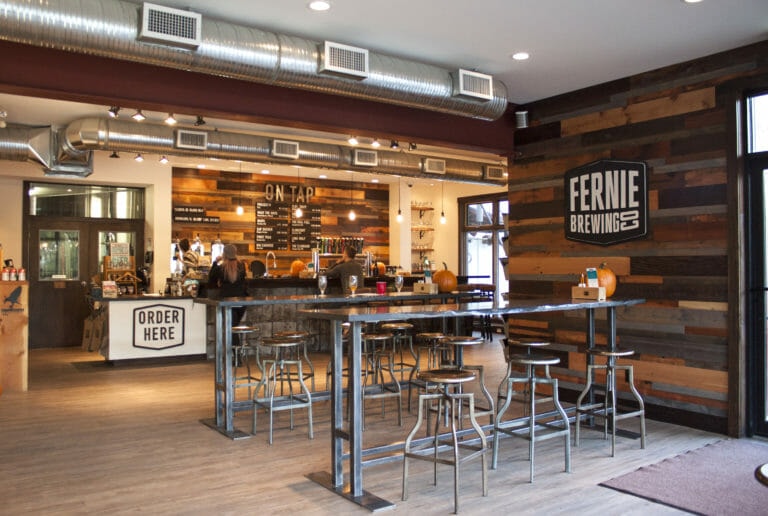
Julia, one of Fernie’s staff, prepares three boxes with four tasters each and lays them before us. It’s a massive offering, but she’s placed them in a specific order to help us get the best taste experience, suggesting we start on the left and work right. Individual cards with a name and description correspond with the style it’s placed behind.
It’s a fine-tuned process, one that demonstrates the detailed work that Fernie Brewing’s team has put in. Though there are 12 selections on tap, for a brewery this size, they could likely squeeze out even more. But Julia describes this as a deliberate choice.
“We can create demand by keeping the year-round selections low and changing out seasonals every few months. It keeps things fresh and keeps our customers looking forward to what’s next.”
As we work our way through the flights, I ask Julia about the “Cheers to Charity” message on the wall. She explains that she started with Fernie Brewing Co. right before this tasting room opened; after it did, the company started a program that donates all proceeds from flight purchases directly to rotating list of local charities and clubs.
Being the founder of a nonprofit, I love this initiative. So do the brewery’s customers: the “Cheers to Charity” is the most popular offering for the brewery. The board below the program title on the wall keeps track of total donations: at the time of our visit, it’s given out $66,000 to community charities.
I’m floored that the company has chosen to give profits away on flights, an option that is such a universally popular item in any tasting room. It gives credence to the importance of community for the owners of this brewery.
The same care is described later during my brewery tour. As I walk through the shining canyon of brew tanks that leads to a towering wall of multi-coloured cans, another employee talks candidly about the experience of being part of the Fernie Brewing Co. “family.”
“Everyone here has moved up from within the company, even if they started with just sweeping up,” he says, saying that’s exactly how he got his start. “The owners put employees through schooling; they train people up to where they want to go within the company.” He describes the work environment as a place “where you don’t have a boss on you, but a mentor.”
Back in the tasting room, Julia agrees. Even as one BC’s largest breweries — in the top 10 — she calls it very relaxed. “Lots of us hang outside of work.”
Brent and I take our leave as the team begins tidying up for the night. While here, we met mountain bikers from the States, a photographer from Victoria, and a team that is fiercely loyal to their brewing family.
Fernie Brewing Co. Beer Picks
What the Huck: ABV 5% • IBU 15
This Huckleberry Wheat Ale carries its huckleberry sweetness throughout the sip, lingering right through to the next. A year-round beer, the berry stays true to its natural fall flavour.
Pumpkinhead: ABV 5% • IBU 13
Fulfilling, dark, with a slight bitterness at the end. With nutmeg flavour on the tongue, this is a fall seasonal you could drink alongside a slice of pumpkin pie.
The Eldorado Single Hop IPA: ABV 6.4% • IBU 75
Forefront on this winter seasonal is lemongrass — and, yes, hops. In addition to the IBU, “El Dorado,” being a variety of hops, is testament to the beer’s flavour focus.
There’s magic to be found on Kootenay back roads — where we’re headed next. The unpaved wanderings of Mt. Fernie Park Road lead us through its provincial park namesake and old growth cedar, past a couple dozen or so mountain bike trails, and then into view of the Three Bears. It is here, under Mama, Papa, and Baby Bear — peaks in the Lizard Range — that we finally put the car to rest for the night.
More specifically, we’ve arrived at Island Lake Lodge.
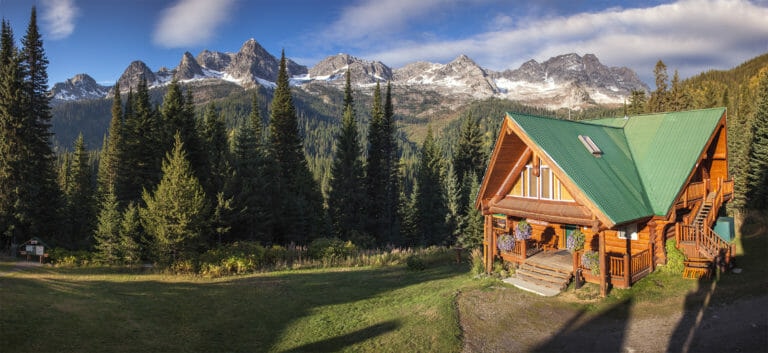
Four lodges make up this resort. Well, four lodges, two restaurants, a wine library, spa, views, and — in winter — legendary cat skiing.
We’re staying in Tamarack Lodge, one of the lodges housing a restaurant. We pull our luggage in and transfer it to our room upstairs. I’m always happy for any chance to sleep high in the mountains, but rarely does that chance come with bath robes and soaker tubs.
Here it does.
Brent heads down to make a reservation at the restaurant and I open the windows wide to take advantage of that perfect pine scent that’s synonymous with mountain air.
I decide against trying to connect to wifi. Though it’s available here, Island Lake makes no pretensions about it being a stable, speedy connection. Rather, they promote to its lodgers a chance to enjoy a rapid connection with the mountain environment.
Our dinner reservation time comes close, and we move downstairs. Seated within a dining area built of heavy timber, one wall has window into a wine cellar while another has windows to the evening view. Though a cloud layer prevents a view of the moon, the Three Bears are in full view, tinged blue in the fading light.
We order the pork belly appetizer along with the house wine, “The Three Bears Blend.” The latter is an exclusive house blend co-created between the restaurant’s manager and BC Wine Studio, a wine broker based in Okanagan Falls. A white version is available, but the red is chosen and arrives, full of dark, slightly sweet fruit and oak.
Delivered in alongside the wine is the pork belly. Being a native of the southern United States, I’m no stranger to pork belly and figured by the time I left, I’d had it served every way possible. But when our dish arrives, I’m surprised. Translucent slivers of radishes line individual leaves of brussel sprouts, filled with crusted pork belly, onion puree and topped with sweet mustard.
There’s sweet, there’s crispiness, there’s richness and there’s a bite of acidity. In each forkful, the flavour moves through complex stages and I find myself wanting to gobble it all up. But I push the plate to Brent half-heartedly, hoping his disdain of brussel sprouts will dissuade him from eating it. But the single leaf of the vegetable does nothing to pause his partaking, and I see the plate cleared.
C’est la vie.
We ate our main courses — mine was the perfectly rendered duck breast with pickled carrots; another delicious surprise — in a relaxed state. Mountain settings will do that to you; it’s just the thing to transport you out of a hectic, deadline-filled life and make you feel as if all of that rush was just a dream. Here, in the warm light of the dining room, with no phone, no sound of cars rushing by, and no need to be anywhere else, I focused on the soft conversation broken only by the occasional clink of utensils scraping up the very last of a delicious meal.
My sleep that night was broken only to close the window a little because of the drop in temperatures. Looking into the inky blackness, I noticed pinpoints of light — thousands of them.
Sometime between dinner and this early morning hour, the blanket of clouds had disappeared, replaced with a blanket of stars.
The next morning the sun’s light is sandwiched between clouds, creating a beam that hits the centre of Wolverine Peak. With that pine scent still strong, it’s a beautiful way to wake up.

We head down for breakfast and meet Mike, the director of sales and marketing at the lodge, on his way in to grab one of the chef’s daily pastry specials. The three of us form a group and sit near a window for breakfast.
It’s my chance to ask him about the hiking trails that start at the lodge, plus more about the lodge and ski terrain. And Mike is ready for those questions. He seems to know every detail about the place; not just the standard marketing info that gets sent to magazines, but the deep history, the trail building, the troubles met along the way, and the backstory to the area’s entrance into winter fame.
You could say he wrote the book on it — because he did. He disappears into another room and comes back with two photo-centric books: one is a cookbook with recipes developed by the Island Lake Lodge kitchen (which I can’t believe I can try to recreate at home) and the other is Bears Above the Valley: A History of Catskiing and Snowboarding at Island Lake Lodge. Mike’s name is stamped on the bottom along with photographer, Mark Gallup.
He gives me an auditory summary of what I’ll find inside, describing how, since the 1940s, locals have made good use of the 12 metres of snow that fall annually on these slopes. But it was at the tail end of the last century that a ragtag bunch of pro skiers, riders, and media folks scraped together the money to buy the land from a major oil company, literally within minutes of the seller’s deadline, turning it into into something that grabbed the attention of every major ski publication: a cat ski lodge with a tenure spreading over 7,000 acres of epic, skiable terrain.
“These days,” he adds as we receive our own to-go boxes holding a croissant pastry, “those epic ski days are ended, on slope, with a ‘last run beer’ for each guest: The ‘Papa Bear Pilsner,’ our collaboration beer with Fernie Brewing Co.”
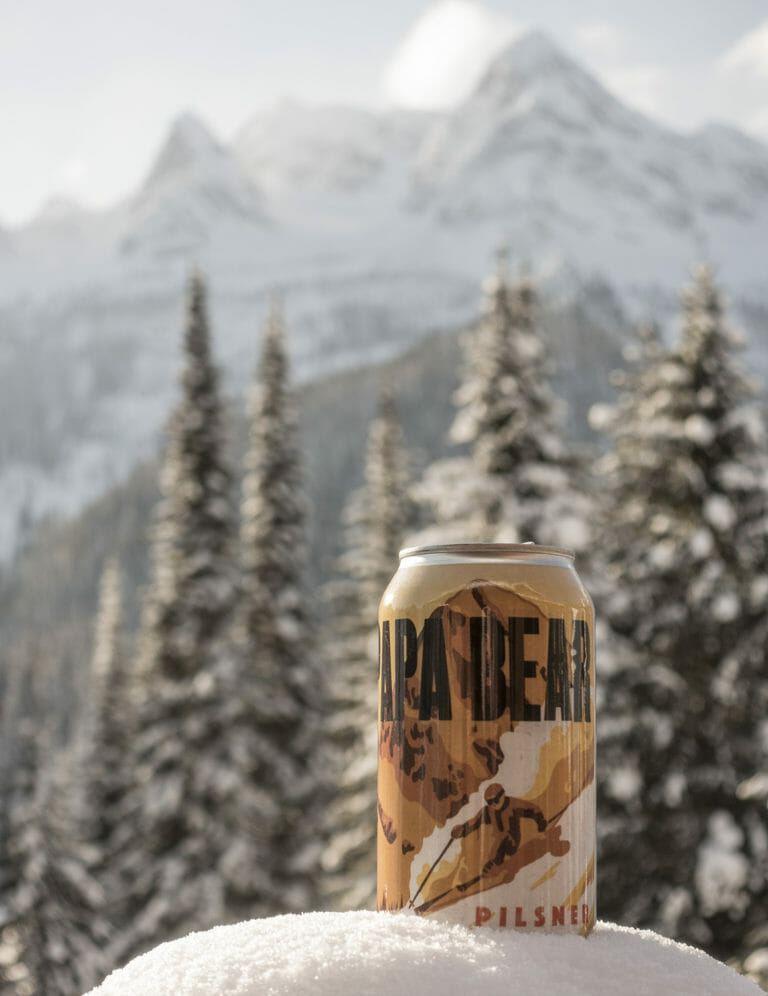
I’m starting to see a pattern of community collaboration with these Kootenay craft breweries.
Due to my knee injury, Mike sends us out on the easy-strolling Lake Trail and its extension, the Fir Trail, assuring me that many of the great sights can be viewed from this lower altitude, too. The path is mostly smooth, with a few polished roots along the way, but tight, shaded and winding, keeping me guessing with its game of “what’s around the next bend?” What we find: tiny creeks, hidden outcroppings with lake views, giant old growth, and quiet.
It’s a great trail for a run, so I pick up the pace, stopping at interpretive signs and the lodge’s “Iconic Photo Spots.” These spots are identified with signs helping the would-be Instagram star feel secure in capturing scenic shots. Mike’s words ring true: Five of the 12 “Iconic Photo Spots” located along the lodge’s trail network, including the most photographed point, The Boat Launch, are included in our loop. And despite my hesitation to take a photo in the same place where others take them, I give in; this lake and mountain combo is just too scenic to pass up.
An hour and a half later, Brent and I unbox our pastries, so flaky we choose to eat them before getting in the car. Besides, we just made great time on the trail and those little treats were just asking to be consumed.

Day 3
Leg Three: Fernie to Kimberley
We cross back through Cranbrook and over the St. Mary River where it snakes through an evergreen forest. We’re winding upward from here, heading to one of Canada’s highest cities: Kimberley.
Home to British Columbia’s largest municipal park (840 hectares within city limits) and part of the National Geographic’s “Crown of the Continent” region — a partnership working to preserve geographic character and heritage through geotourism — Kimberley is also home to craft brewery Over Time Beer Works. The latter is where Brent and I have our GPS set to lead us.
We pull up at the outskirts of one of my favourite aspects of Kimberley: the Bavarian-styled Platzl. This little city of around 7,500 people has over 30 restaurants and cafes, lots of local shops to duck into, and many of these are found surrounding the Platzl. Brick-lined, vegetated, and pedestrian-only, this little centre also serves as a spot to people watch and relax in Kimberley’s onslaught of sunshine — 2,125 hours of it per year, more than most places across Canada.
Today, we’re using it as a scenic shortcut to Over Time Beer Works, with a pit stop at Healing Hollow Essential Oil. The outside of the shop has a classic wooden storefront that you’d expect in days gone by with an interior that’s light and cozy.
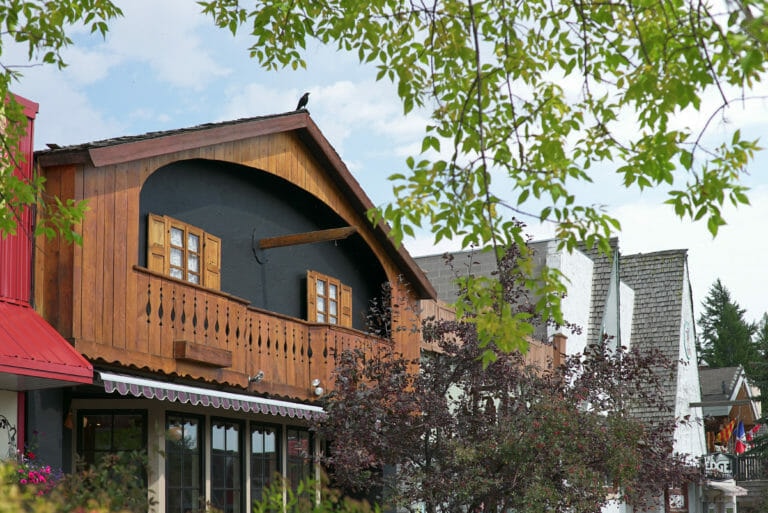
Michelle, the owner, setting up a display in the shop’s windows when I walk in, so I continue to talk to her as I scan the cubbies lining the wall, each containing an essential oil blended on site.
She shares how Kimberley’s stores, especially in and around the Platzl, are mostly independent findings opened by young entrepreneurs. “They also tend to be mostly female entrepreneurs around here,” she adds.
This raises my eyebrows. Though I get excited about young entrepreneurs from both genders, I find it interesting to hear of a place where women are taking the economic lead. She lists off the places nearby that were started by women, and the number feels significant in relation to the stores I can see from her window.
Without further proof to back up these statements, it might just be anecdotal evidence, but if true, it may also explain why this little corner of the Kootenays exudes a distinct vibe as compared to the downtown areas I’ve enjoyed elsewhere.
I purchase a vial of oil as a little gift for Brent, who is waiting outside. He’s set on getting to the beer, so I appreciate that he isn’t hurrying me along. But when I find him, I see why: he’s found a set of steps that’s situated in a block of sunshine where he can watch people coming and going.
We continue our diagonal shortcut across the Platzl to the opposite outskirts from our parking spot to reach our destination. Clad with new aluminum siding and wood paneling, the exterior makes industrial look modern. A smart logo burns above the entrance in fire-engine red with clean lettering: Over Time Beer Works.
Simple. Clean. This brewery looks like it gets down to business.
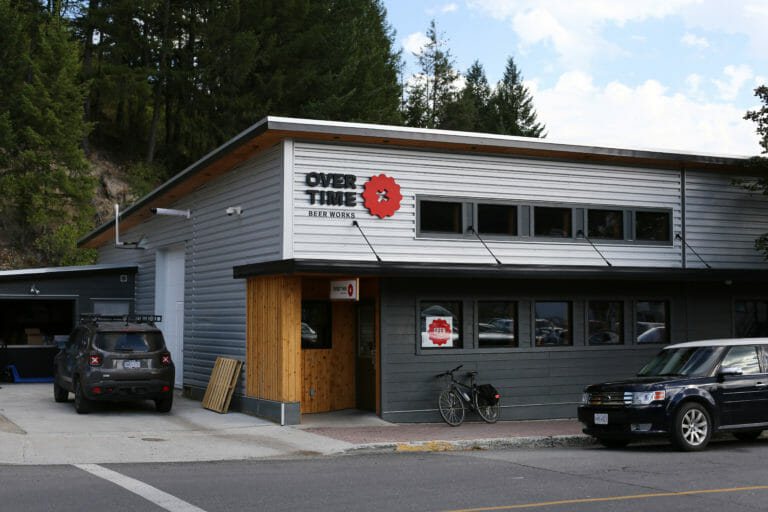
Brent holds the door open for me and right away, I hear voices talking. The tasting room is by far the smallest of the three we’ve visited so far, but I like what I’m seeing: a well laid out space with a compact seating area and bar, but more importantly, customers talking not only with each other and with the man serving the seven beers on tap.
That man serving that beer, come to find out, is also the owner, Kenny Dodd. A Kimberley man born and raised, he returned after a stint away from his Kootenay roots to deliver what he felt this mountain town needed most: a brewery. The inspiration to pursue this path grew in the years following a road trip into the U.S. Pacific Northwest — noting Oregon especially — sparked his interest in craft beer.
With Over Time, he wanted to keep the focus on approachability. And most of that, he says, depends on the finish, that final taste left in the mouth after drinking a beer.
“Overall, we try to focus on the balance and the finish,” says Kenny. “People’s perception is based on the finish; if it lingers bad, they remember that.”
With that, he pours a round. Well, technically a flight, but it’s served cleverly in a circle on a wood cutout of the brewery’s logo. This is another brewery that has their branding dialed. As a marketer, I love seeing thought put into the company details, even if, like here, they’re kept simple and straightforward.
It suits the brewery. Kenny comes across as having straightforward nature, but now and then a spark of playfulness comes though, too. The brewery’s branding and marketing messages feel like an extension of his personality — at least what I uncover while sitting here in his brewery. One example is taken from the website, which states that their beer is brewed with “… a little sumthin’ sumthin’, and a solid dose of inspiration.”

That little “sumthin’ sumthin’” could be referring to the hundreds (if not thousands) of huckleberries that Kenny’s mom handpicked near the Kimberley Alpine Resort for their Huck Sour beer, or the local yeast that brewer, Matt Phillip, gathered from the Platzl for their take on a Berliner Weisse. Either way, these wild ingredients show that they’re proud of imparting local flavour to their offerings.
And that’s something they have to work extra hard for. Apparently, in Kimberley, the water is just too dang pure. I don’t readily grasp the problem until I realize regional water differences often impart the flavour differences between breweries that might use an otherwise similar recipe for their beer styles.
“The biggest hurdle was dealing with the water,” says Kenny. “The water is so balanced, it registers almost a perfect 7 on a PH test, lacking the minerals most water has.”
This means they have to get even more creative — and that’s okay with Kenny who says it’s the day-to-day variety of tasks that go with owning a brewery, as well as the variation that comes with brewing, that keeps him from feeling stuck in a rut.
He compares it to other industries where you have defined barriers and things that need to be called by specific names to be recognized within the industry.
“With beer, you have two ingredients, then you can go anywhere with it.”

What strikes me is how loyal the locals are to this place. Since I’ve been in, only one or two people have filtered out, while others have come in to join the ranks and watch the hockey game. They all know Kenny and he knows what they like, filling up a glass for them almost as soon as they sit down.
“It feels like I’m part of the community here,” says Luke, a newcomer to Kimberley by way of Brisbane, Australia. When he first arrived in Canada, he missed his hometown local hangout until finding Over Time. “It’s nice to be able to just go in and talk to people. They throw on the hockey game for me and just shoot the breeze.”
Over Time Beer Works Beer Picks
Berleyner Weisse: ABV 5.2% • IBU 8
Keep this one ice cold because it heightens the crispness. With yeast gathered from the Platzl and huckleberries gathered by Kenny’s mom, this beer has a hit of sour near the back of the tongue on the first sip, and then the huckleberry comes in with its natural sweetness. Keep a growler fill of this; you’ll want a few glasses.
Copper Top: ABV 4.8% • IBU 35
This red wheat ale has the characteristic banana aroma and slight spice taste of a hefeweizen, with a seriously beautiful colour. But the locals sum it up best: Says one patron at the bar, “It’s crushable.”
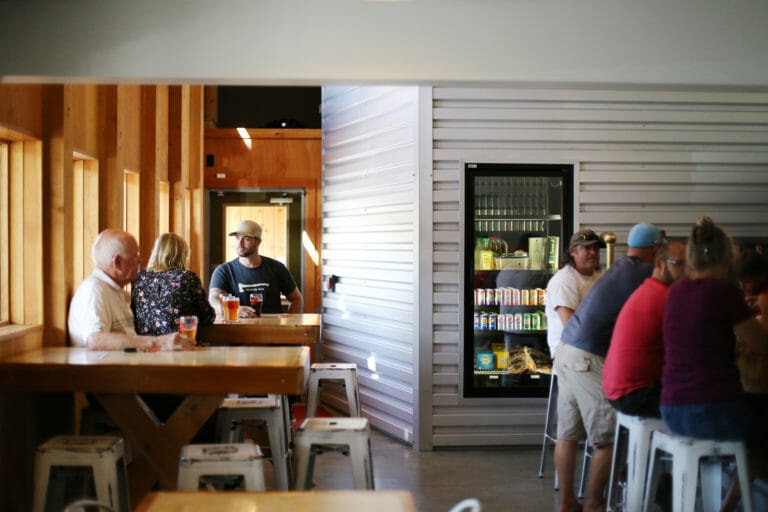
We walk back through the Platzl, searching for the Pedal and Tap restaurant. It’s come recommended by each of the locals at Over Time, and when I walk in, I see why. A board filled with well over 50 beers, plus a number of other beverages for the non-beer drinking crowd, is proudly displayed on one wall, a bar lines the back, and a easy-going, retro-vintage inspired interior runs throughout.
We both order the Coop Du Jour, but I take the chance to “muck up” my fries. When the meal comes out, I see may not even get through even a portion of the fries: they’re slathered with mozzarella, aged cheddar, maple bacon, green onion, and topped with housemade chipotle sauce. This is in addition to two thick cuts of chicken with plentiful buttermilk breading, slaw, and house-made cherry bbq sauce on a ciabatta bun.
Oh, it’s so big (and messy, and delicious, and…), they serve it on a parchment-lined baking tray. #OMGoodness
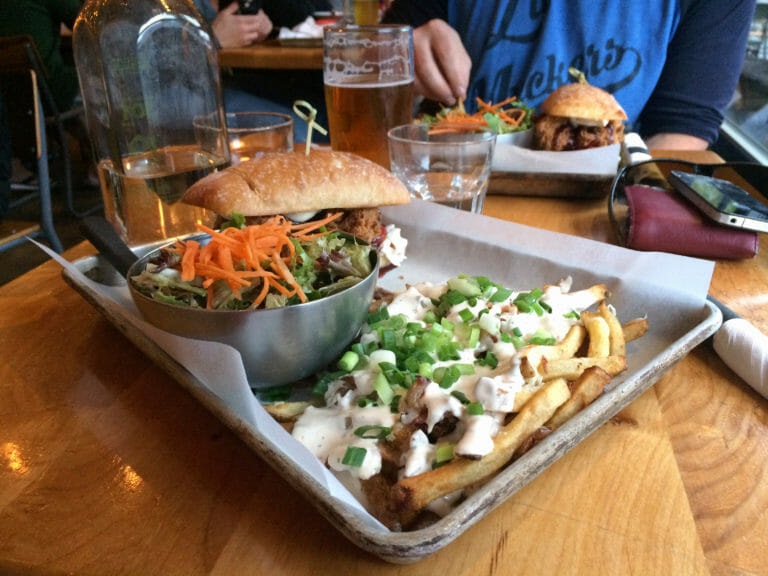
Day 4
Leg Four: Kimberley to Invermere
A spectacular, scenic drive takes us north to Invermere.
The food is still sticking to our ribs by the time we check in at Invermere’s Copper Point Resort a few hours later. I’m holding a full to-go box along with my luggage as I open the door to what I think is our room. Instead, it swings open to reveal a full condo: kitchen, laundry, grill on the balcony, master bath, leather couch and two big fireplaces to lull me into a sleep.
I toss my leftovers into the fridge and flip the switch to turn on the fireplace in the bedroom straight away. Whether real or a realistic simulation of a fire, there’s nothing much better on a fall night than having the warm glow of a flame.
There are more pillows on the bed than I know what to do with. I sink into the softest. While Brent stays up to catch up on the game via the living room’s giant screen, in the bedroom, my dreams start to taking over for reality.
I sleep perfectly without waking; a rarity.
The morning shines across the wood slats on the bedroom’s balcony door, and I step outside with bare feet into the crisp air. The air is so clean that the morning sun is amplifies the colours around me: Gold leaves quake in the breeze and the golf course looks as though it has a wet coat of green paint that was just applied a few minutes ago.
Though there’s no soap for the washing machine, I still take the opportunity to run a few of my clothes through the wash since I tend to pack light and play in the dirt too much, forgetting I don’t have much in the way of a change of clothes.
It works well enough. Brent wakes and we walk around the resort a little, checking out the gym and spa before getting a few tips from the staff member at the resort’s activity centre. He’s a local and eager to share his knowledge of Invermere. Loaded up with local maps, circled for the spots he thinks we’ll like best, we pack up the car with our day’s plan ready: local parks, Arrowhead Brewery, and Kootenay National Park for its hot springs and a little hiking.
“But first,” Brent says, “coffee.”

I know just where to get it. Here, along the Rocky Mountain Trench, Kicking Horse® Coffee has achieved international acclaim.
As Canada’s top organic and fair trade coffee roaster, I’ve seen their nearly solid-black packages line the shelves of grocery stores everywhere I’ve travelled within BC, so of course I’m curious about the source now that we’re so close.
Their combo cafe-production facility sits near the headwaters of the Columbia River and right alongside the road between the resort and downtown Invermere. I glance at the entry of Kicking Horse Café while parking. Native landscaping borders the patio, people sit with cups under the awning, and the cafe itself is human-scale. The latter surprises me — I expected to be overwhelmed with an intimidating, industrial-looking exterior, but it doesn’t look at all like company that was recently sold to international coffee giant, Lavazza.
The approachable vibe continued within doors, too. The baristas greeted us with an easy-going attitude, and while the large interior had a sophisticated feel to it, the warmth from the employees emanated from behind the service counter. Even when I mixed up my order (being a person who doesn’t know a hot chocolate from a steamer from a latte), my request for a little bit of steamed milk to add to my drink was met with an entirely fresh cup and a smile.
Caffeine mission complete, we head downhill toward town.
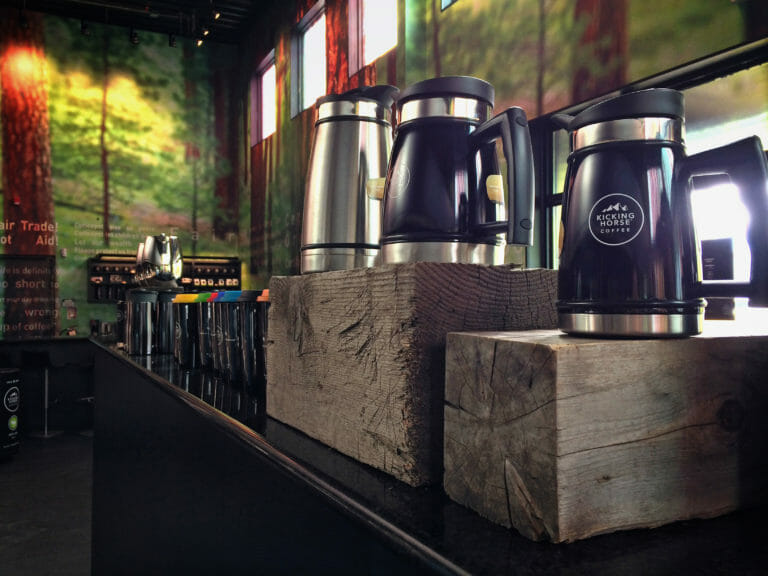
We stop first at James Chabot Provincial Park along Lake Windermere and take a few minutes to walk on the boardwalk and read a few interpretive signs. There are plenty of families here throwing rocks from the wide beach and playing with their toddlers on the playground, as well as folks walking their dogs on leashes. The interpretive signs point out the various elements of biodiversity that can be found in the wetland that is separated from the lake by the boardwalk and beach.
However nice these features are, the park — at least in this season — feels more geared toward families with little ones. We head off to the next park, Kinsmen Beach, that borders the same lake. It has more of a “tucked away” feel, even though it’s just as easy to reach and probably just as popular in the summer months as the other.
Here, it’s simply a visual preference: I like how the land closes in on the lake to focus the view into the horizon, and the way the park’s vegetation and mountains on either side interact with the lake view.

We walk along the shore for a few minutes and talk about our thoughts about our road trip so far, now that we’re about half way through. We move toward the grass, and I spy a little log building with a dining deck fronting the lake. Not having eaten yet, we move toward the patio figuring it’d be a beautiful spot for a meal — and it would have been, had we arrived on any day between Wednesday and Sunday, which wasn’t the case. I begin heading back to the car via the opposite side of the building when I spy an “Open” sign inviting us in.
So in I go. Once inside, it becomes apparent, based on the installments of mixed media adorning every room — from glass to paintings to literature — what I’ve entered: I’ve come across a gallery. But not just any gallery; this is the home of the Columbia Valley Arts Council, an organization that supports regional artists from Canal Flats to Spillimacheen.
The gallery, known as Pynelogs Cultural Centre & Art Gallery, is run by Jami Scheffer, executive director of the organization. She just happens to be the one who greets me as I come in, looking lost, and is the one who helps me get my bearings.
Explaining that the Columbia Valley Arts Council, and by extension, the art gallery I’m standing in, serves to “fill your senses,” Jami describes all types of artistic features that have been shown here: visual, performing, even food arts, the latter are demonstrated through the currently closed (to my hungry belly’s dismay) lakefront dining on the opposite end of the building.
She mentions it’d be worth my time to come back on a day when it’s open.
I ask Jami what she’s most proud of with the Columbia Valley Arts Council. She lists examples such as the “Art from the Heart” show featuring 700 art pieces created by elementary-school children and the annual centrepiece event “Wings over the Rockies” when 100 arts events throughout the valley take place. But overall it’s the mission of the organization:
“We bring arts to the people and people to the arts.”
On our way out, Brent mentions he spotted something across the street that he’d like to take a look at.
It seems that our choice to head to Kinsmen Beach has landed us in a gold mine of Invermere exploration.
He leads me over to Taynton Bay, a new distillery right across from Kinsmen Park, and below “The Station Neighborhood [sic] Pub.” The staff are inside and happy to pause and talk with two kids wandering in from out of town.
They share that the distillery is the first in town and something the community has been receptive to. Similar to the breweries we’ve visited, the distillery’s team has partnered in many creative collaborations with the community and regional businesses, including working with pickling vendor, Sophie’s Original Choice to create a pickled vodka.
They have it ready to try. Mixing it into a caesar, Brent takes a sip and gives his hearty recommendation. Next, they supply him with a taster of straight “Sinferno,” a cinnamon-infused spirit that apparently knocks his socks off.
He buys a bottle.
Their process for perfection? “Everything is flavoured using real food, real products, with nothing artificial.” And if they aren’t happy with the result of a batch, they keep creating and iterating until they are.
Simple.

We thank them for letting us interrupt their day and head back into the sunshine, where I notice the restaurant above advertising that our next stop — Arrowhead Brewery — is on tap. With Brent clutching a burlap bag filled with local spirits and our day slipping into afternoon, we cross back through Kinsmen Park and into the car, regaining focus on our road trip’s primary theme: local beer.
Winding back up to just across the street from where we started our day, Arrowhead Brewing stands in a perpetual faceoff with the Kicking Horse Coffee facility.
From the moment we walk into the door, I realize this place is different.
Have you ever walked into a buddy’s shop, garage or man cave and felt the outside world drop at the door? Grab that feeling and apply liberally here, because that’s what walking into Arrowhead Brewing is like — after you give way to your initial surprise. It’s an explosion of vintage signs, refurbished furniture, and posters styled with mid-20th century graphics, and it sets the mood for the visit straight away.
I love it. We may spend just as long looking at everything as actually trying the beer.

The back wall is littered with beer styles, each written on time-worn, branded tin placard. We mosey back to investigate and meet Leanne Tegart, co-owner and wife of brewer and Arrowhead partner, Shawn. She has got one of the brightest smiles — the kind that matches the eyes — I’ve ever seen and it jumps to the scene as soon as she spots us heading her way.
Before even telling her that we’ll have “one of everything” (which is a lot; they’ve got at least a dozen beers going) I have to find out more about the decor. I’m a huge fan of the 1940s, especially posters from the era so I start there.
“Oh, all of this is Shawn’s,” says Leanne, who explains that he’s a collector of authentic vintage pieces, and this isn’t just a facade created for the brewery. “We already had half of the decor on hand; he’s just been bringing what you see here up from his shop.”
So this decor is an authentic representation of the owners. Even cooler.
Brent and I take a seat at one of the one of the tables and Leanne places a tray lined with paper indicating the beer brands that are aboard. Then more appear — and more — until Leanne has provided us with each style they have on tap.
She sits with us like an old friend. Arrowhead’s story, sharing their mission, their passion for beer, and the trials of trying to make inroads with craft beer in an area that had satisfied themselves with mass-market beer.

It is the latter that really lights her conversation. When they first opened their doors in 2012, their mission was to spread the love of craft beer to the masses, especially to those that usually reach for the Budweiser and Coors beers of the world. So they started with an easy beer to make it more accessible to those drinkers in hopes of making the conversion process easier.
The result combined a love of retro and craft beer: the Blonde Bombshell, a beer that’s remained on tap ever since.
It’s also a beer that, through the years, Shawn continues to enjoy making. It might be because of its tie to his grandfather. The beer was brewed in memory of this man that left a big impression in Shawn’s life, a man with a strong work ethic, a man that served his country. From the Blonde Bombshell’s brew to its label, which displays a rendition of the plane his grandfather flew in WWII, Shawn talks proudly of this beer and the man who inspired it.
“He probably gave me my first beer,” he adds.
A few months into the business and they began churning out additional styles, with playful names like “I’m So Freaking Hoppy,” the third beer the Arrowhead offered. Shawn comes up with both the names and the styles, saying he enjoys the creative end of brewing. The flavours are all based on a simple premise: “It’s what I like taste wise.”
Based on the variety of styles before us, he and Leanne have plenty to work with when it comes to taste. And, true to craft beer, they look local to source those flavours.

Reaching out to the farms and businesses in the area, they use pumpkins from Windermere’s Hopkins Harvest (which Shawn splits and roasts for their “PunkInferno” seasonal), rhubarb from one farm (“Redrum” Rhubarb Rye IPA), raspberries (“Berries of the Night” Raspberry Wheat Ale) from another, honey from their own bee hives (“Original 83 Honey Ale”), and coffee from right across the street (“Midnight Special” Porter and “Kick Ass” Coffee Cream Ale).
The four of us shift from the tables to the green, overstuffed couches near the entry. With both Shawn and Leanne beside us, chatting about the craft beer industry, the local community and the entrepreneurial drive that every craft brewer needs to possess, the feeling of “old friends” grows. I’m fascinated by the stories that accompany not only their brewery, but each individual beer, and their work toward becoming an ingrained part of their community. The amount of reciprocity and cycles that their product goes through is commendable: purchasing from local farms, giving back their spent grain and beer to local artisans and food producers, and receiving the end product to display at their brewery — such as beer soap and jars of beer-based preserves.
The sincerity that comes through in their conversation manifests itself throughout their brewery, in their beer and in their warmth. If you’re in Invermere, stop in for a pint and ask for a story.
Arrowhead Brewing Company Beer Picks
Berries of the Night: ABV 4.5% • IBU 20-25
This summer seasonal raspberry wheat ale uses local raspberries with no syrups or flavourings, creating a beautiful berry underlier that carries throughout the sip through to the lingering flavour after cup is empty.
Black Jack: ABV 5.4% • IBU 30-35
Rich and creamy, with a satisfying roasted coffee flavour. Pick this up on a cold night for some comforting malty goodness.
I’m So Freaking Hoppy: ABV 7.3% • IBU 75
This Imperial IPA is strongly citrus-forward. Being a Florida native, I liken the flavour profile to a orange peel with a pithy, grapefruit bite of bitterness on the end.
After a hard day of art galleries, beaches, spirits, and beer tastings, we’re off to Kootenay National Park for Radium Hot Springs.
North of Invermere, I turn into the park. It soon closes around my car; on either side, our view is cut short by a wall of mountain, sometimes set further back and soft with vegetation, other times craggy and jutting up close to the car’s windows. It’s shortly after the road cuts directly through rock that a park sign directs us to pull over for the pools.
Brent and I join other visitors in the underground tunnel that connects the parking lot to the hot springs on the other side of the road. When we reach daylight again, I’m walking above the first of two pools and into a mid-20th century heritage building — the aquacourt — to gain admission. Brent’s forgotten his regular swim shorts, so they offer to rent him one of their 1920s-style swim outfits.
I think he should take them up on it. He opts to don his mountain biking shorts instead.

The pools are massive, with one designed to hold hot water and the other cool. However, I come in the midst of a massive three-year, $5.7 million investment plan that’s nearing completion. Currently, the cooler option has been halted while Parks Canada forges onward with the biggest improvement project the facilities have seen since the aquacourt’s 1951 opening.
Though the springs were visited by the Ktunaxa people long before European settlers arrived, the pools started their modern-day journey in 1914. It was then that a paralytic man, Hargrave, invested in an upgrade that took the hot waters from flowing into a single-person soaking tub and into a concrete-lined pool. This charitable act came when, after soaking in the waters for three months, he found he was able to wiggle his toes. Convinced that the hot spring was responsible, he fronted the money to enlarge capacity, allowing more people access to what he viewed as “miraculous waters.”
Today, the new upgrades are focused less on increasing capacity and more on safety upgrades, energy efficiency, and preserving the historic glory of the pools’ past. Karin Smith, Marketing Coordinator for Parks Canada’s Canadian Rockies Hot Springs, walks with me from the front desk through the rarely-seen underbelly of the building and out again to the pool, pointing to changes that have taken place already and areas of historic significance.
“We’re bringing the building back to its former glory of the 1950s,” she says, “but bringing in modern equipment, upgrading the walkways and mechanical systems, and putting to use the geothermal energy that is readily available here.”
As we walk out of a tranquil spa in the lower level of the building, she gives a comparison of environmental perspective from 1950’s thinking vs. today:
“Green was just a colour in 1951.”
The realization strikes home: our ideas about the earth, its resources, and the other living beings that we share it with have changed drastically in the nearly 70 years that have passed. Her words spark excitement in me about the potential for these renovations to preserve the spring’s past, connecting visitors to Radium Hot Springs’ history and healing well into the future.
Brent reappears from the pool, wet hair, a bag of wet clothes at his side, and a demeanor of relaxation. The springs have worked their healing magic again.
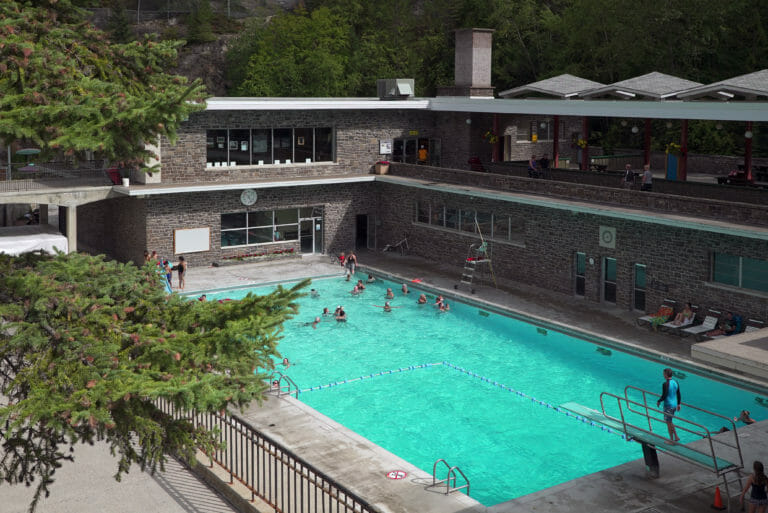
Day 5
Leg Five: Invermere to Golden
The road from Radium Hot Springs to Golden is one I’ll always have a place in my heart for.
It was this stretch of road where, when I was living in my car, I lost my heart in the roadside scenery.
How could you not fall in love with this passage north? It traces the Columbia River as it braids through a valley that’s sandwiched between two massive mountain ranges, both holding all the adventure one explorer could wish. Each turn of the head affords another idyllic view.
And here we are, travelling along, watching the scene decked in autumn colours, the sunset casting the land in its “golden hour” glow.
Based on the way the sun has played with the landscape over the length of this road trip, I’m starting to think it has a special place in its heart for the Kootenays too.
We arrive in Golden after dark and walk through town to meet with local friends for dinner at The Island restaurant. The streets are quiet and town feels like it belongs all to us — that is, until we get to the restaurant. Here, a group is gathered at the bar, with more coming in to meet them throughout the evening. We place our orders from a menu sporting culinary selections from all over the map. Our group increases the volume of our “inside voices” as the bar crew grows in number and jovialness

It’s great to catch up with neighbours in the Kootenays; it’s the kind of culture that, even if years have gone by, once you see each other again it’s like no time has passed at all.
I squeeze another itinerary item into our schedule the next day while Brent’s still asleep. Yoho National Park is under thirty minutes from our hotel and being this close to the Canadian Rockies means I’ll make it my duty to get there.
Brent awakes with me already showered and putting my bags by the door. He has a questioning look in his eyes as to why I’m bustling about so early.
“Time for Yoho,” I say. He doesn’t ask any questions, just gets things ready. He knows my wandering spirit will pursue the furthest reaches until some sort of tether — a schedule, in this case — snaps me back.
The sun is bright in our eyes as we head east toward Yoho. Clouds hover just above tree level, and we hover just above that with the highway lifting us ever skyward toward the great Rockies. I’m in awe, like always, that this beauty is within reach.
We decide on a short trail to begin with. Because of the ease of access, Wapta Falls is a popular hike, so getting there before sunrise means we’ll be free of most of the trail’s traffic during our approach.
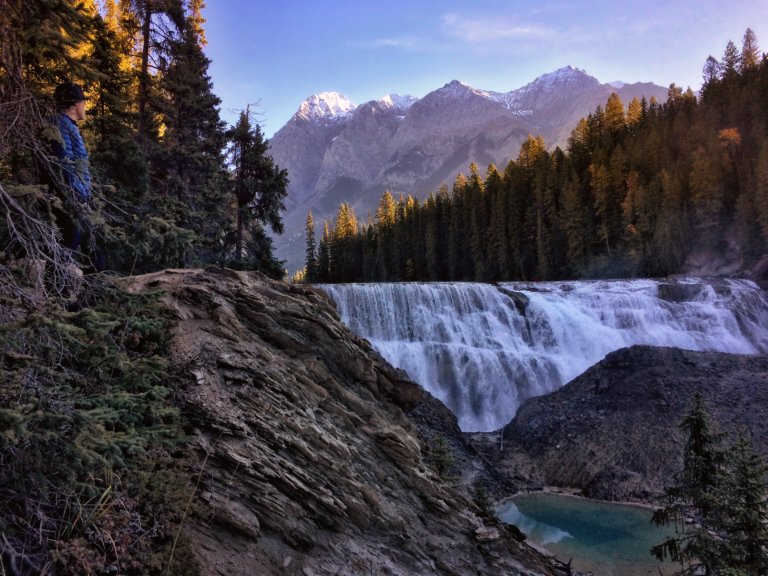
The air on the densely wooded trail is like breathing in frost. The ground is damp, the sun is just beginning its daily ascent and I’m feeling so incredibly alive.
Without meeting a single person on our way in, we reach the falls in short order, stopping for just a short time at the main overlook, then meandering down the trail to get even with the roar of the water.
The velocity of the falls sends mist high into the air, and the sun catches the bits that fly into its low-angle realm. Working its way above treeline, the shadows are tinged purple and the cloud of overspray turns gold. Standing there, with nothing but my boyfriend, the roar of water, and this view, I can’t imagine a better way to start the autumn season.
“Better than pumpkin spice latte,” I think.
We stare until others begin to gather above us and take our cue to head out. I prefer my outdoor time with more of nature’s voice and less of other people’s and Yoho provides plenty of ways to ensure this balance — as long as you steer clear of the easy, pull-over-and-hike trails.
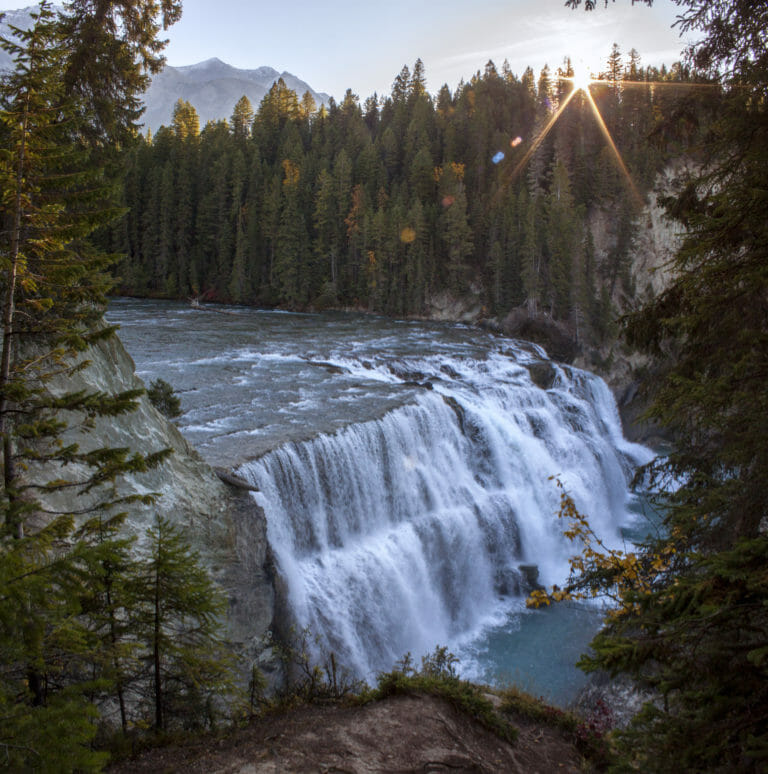
Brent and I navigate toward a campground with a sign that states that it’s closed for the season. But most people don’t realize the hiking is still open to the public. We pull in to an empty lot and start toward the Hoodoos trail. We pick our way across rocks in Hoodoo Creek since the footbridge is gone, and start up the never-ceasing-until-you’re-there incline.
A burn area midway up lets us see out across the valley, mountains blocking the view from slipping into eternity. Hoodoos begin to take shape in the mountainside just beyond, but it isn’t until the end of the trail that we catch them in their full form. We choose the lower fork and stand at the base, looking up, with the river running by our feet. One raven flies overhead, but other than that, it’s quiet.
This time, the trail is devoid of other hikers during the return, too. Since waking up, we’ve logged 29,745 steps before most people have had their first coffee break at work.
That’s a feeling I could use more of in life.
Brent and I head back to Golden to ascend another mountain, this time by gondola. We’re in the Purcells, being lifted to Kicking Horse Mountain Resort’s Eagle’s Eye Restaurant, the highest-altitude restaurant in Canada.

The gondola doors open and we step into a sea of alpine peaks and sunshine. A wide summit berth gives each of us room to wander around, losing ourselves in views but without losing each other entirely. It’s a perfect stopping point after being side by side all morning in the car and on the trails.
Inside the restaurant, we order hot drinks and rest our tired quads. Rock candy swizzle sticks accompany our mugs, and I lazily stir mine into my drink until it dissolves. From within this elevated perch, I drink in the view as I drain my cup.
“My gosh, this is for real,” I think.
I turn to Brent with a grin that smothers my face, unable to express the fire of “joie de vivre” that’s building with every passing mountain moment.
But that’s before I come face to face with a grizzly bear.
Boo, they call him.
It’s a planned meeting, and it doesn’t just stoke the excitement I’m feeling; it topples it.
Boo comes near the protection of the fence that surrounds his on-resort habitat while I’m take part in a guided tour. He’s a rescue; orphaned at an age that meant sure death had he not been spotted near his lifeless mother along the side of a highway.
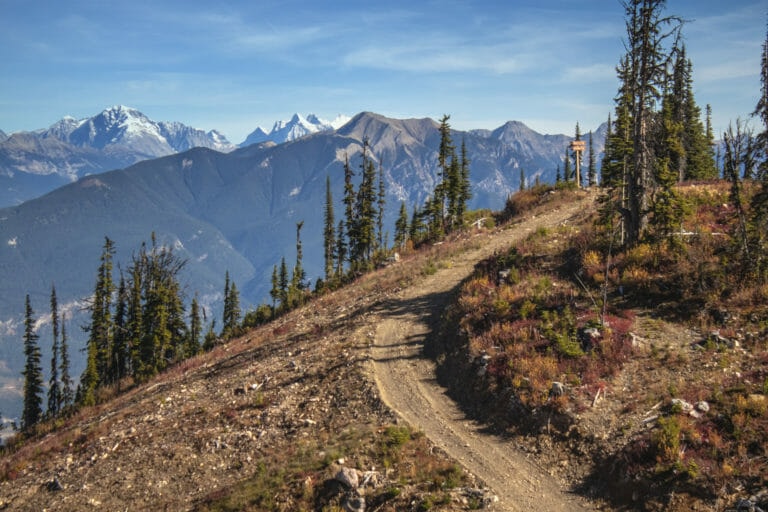
The tour guide describes the space designed at Kicking Horse Resort especially for Boo. Created to help him live as naturally as possible while providing educational and research opportunities, the plot of land is in a relatively flat, no-ski zone that’s surrounded by electric fencing.
But within, he has four microhabitats to mimic the wilderness he’d usually roam had he been raised to maturity by his mother. And though unable to survive on his own, his natural bear instincts are nurtured: carcasses and fish are donated to help supplement what he finds on site and workers hide the food to help sharpen Boo’s sense of smell and navigation skills.
I stare at the massive body now lumbering away from our view and into the brush. He’s soon camouflaged, with only the rustle from his movement letting us know he’s nearby. Soon that fades, too, and I think how good it is to live in an age when the scales are tipping in favour of animals like Boo being cherished rather than wiped away from the earth.
Before descending the mountain, one person in the group pipes up about what they’re doing the rest of the afternoon. Whitetooth Brewing is mentioned, and my ears perk up — we’re headed there next, too. Our guide, who’s been living in Golden for nearly a year on a work visa from Australia pipes up with her insight:
“The flight’s the best. It’ll get you pretty tipsy.”
Sounds like it’s beer o’clock around here.

Whitetooth Brewing already caught my attention with a story I did nearly a year earlier about new winter brews. At the time, the brewery, which opened in December 2016 and its offerings all qualified as “new” brews. As I scanned the brands they offered for the story, I was drawn in by their labels.
I saw each of my favourite mountain sports showcased on those labels: whitewater kayaking, mountain biking, ice climbing, and — naturally — skiing. The bold colouring in the graphics jumped off the screen; I wanted full-size posters of each.
It was a few months later, when a friend was visiting from Utah to ski the Powder Highway that I saw my chance to visit Whitetooth and see its branding in person. Brent, getting ready to open his own craft brewery in Nelson, came along for the beerski combo, excited to see this new brewery he’d heard about.
And now we were back with Kenzie, my friend from town, and high expectations for round two at Whitetooth.
Since we’d last been here, a “backyard” has been added along the back of the shining aluminum-exterior brewery, the clean lines of a wood fence bordering an expanse of pristine lawn. Inside its perimeter, tables for guests to enjoy the afternoon sun were being put to good use.

Inside, things look as fresh as they did when I came in in the winter. Custom wooden tables, with turquoise glass poured down the centre to represent the Kicking Horse River, lent some warmth to a tasting room which is purposefully designed with what I deem a “modern industrial” look.
But, like I experienced in Invermere, the real warmth comes from the staff, who are clearly enjoying their position behind the taps. Smiles are passed all around as we take a look at what’s on tap and, after a few minutes, both Shelley Donaldson and her husband Kent, co-owner of Whitetooth along with Mark Nagao, sit down on the opposite side of our six-seat table, joining us for conversation before inviting us on a tour.
I can spot a bit of the brewhouse and tanks from where I’m sitting through the tasting room window, but the view is always much better served up close and personal, especially with the gleaming new equipment Whitetooth has on deck.
Natural light mixes with bright overhead lights, bouncing off the spotless white. I feel like I’m in Willy Wonka’s “television room” it’s so spotless. I imagine how that transfers over to brewing; a clean slate each day to create with, influenced only by the experiences the brewer brings in from outdoors.

That’s part of the plan at Whitetooth. Named after the original ski hill that existed in Golden before the international-acclaimed Kicking Horse Mountain Resort, the team’s goal with the brewery was to combine the best that Golden offers outdoors with the perfect beer to enjoy at the end of their day.
The outdoor-themed labeling snaps forward in my mind and the branding clicks.
But before they could pair people up with an apres beverage, they first needed a brewery. And pre-Whitetooth, Golden was lacking.
Mark, who was born and raised in Golden, sparked up a conversation with Kent after meeting in town. As will happen over beers, the two got to talking. Someone along the way made the comment, “Man, this town needs a brewery.”
And thus the idea was hatched. “It was the last bonafied ski area in Southern BC that didn’t have one,” says Mark. “Just seemed like a gaping hole.”
Now, for a brewer. As if he knows he’s being summoned, Evan, Whitetooth’s brewer, walks in just minutes after Mark and Kent start talking about this stage of Whitetooth’s beginnings.
Apparently, this is Evan’s style. He also just walks up to Mark and Kent, fresh from Vancouver, asking for a chance to brew for them after reading an article about their plan to open a new brewery. He came equipped with a resume that showed experience brewing with Deep Cove in North Vancouver, samples of impressive Lambic and Bière de Garde home brew, and a heads up that he’d just returned from a Belgian tour driven by his own passion to experience the beer.
He was hired.
Like all good entrepreneurs, the trio started in the garage. “That one year of pilot brewing with Evan was huge,” says Kent. “We had a lot of time to tinker and iterate” giving one example of going through nine iterations of the IPA before it was dialed.
And it seems like the team has a good flow between them. When they were still in that garage-development phase, Kent would leave various spices around Evan’s “laboratory” as hints to add more standout flavour to the wit he was working on. But he also knew when to hold back.
“It’s super important for the brewers to have room for creativity; if you start stifling them, they lose their ‘beer power.’”
The beer power is strong at Whitetooth. Each style is distinct from the other, full of flavour, with nearly every style having a strong foundation in what’s expected of it.
It’s almost an answer to an early worry Mark had before launching the brewery’s first public tasting. In response to his question, “What is no one likes our beer?” Mark was told by another Golden local:
“No one will ever taste a bad beer from you: You’re too picky. Instead of pouring a bad beer, you’ll pour it down the drain.”
Whitetooth Brewing Beer Picks
Thread the Needle: ABV 5.5% • IBU 14
This witbier has a bold hit of warm spiciness at the start, mellowing into a meyer lemon flavour. Though it’s tasty enough to drink all year, you’ll love it in summer.
Launch Pad: ABV 6.3% • IBU 26
A belgian inspired rye ale that manages to be rich with a touch of caramel, but without the typical heaviness of a rye. “I could drink many of these without realizing it’s a 6.3% beer,” says my friend, Kenzie.
Trepanation Tripel: ABV 9% • IBU 40
A Belgian Tripel with a sweet quality that stays true to its Belgian roots. A fruity smell coincides with its fruity finish. “And the logo is awesome,” says Brent.

Day 6
Leg Six: Golden to Revelstoke
After so much hiking and sunshine, I’m ready to call it a night.
After so much hiking and sunshine, I’m ready to call it a night. I’m stoked (no pun intended) to be heading to Revelstoke Mountain Resort for a night at The Sutton Place Hotel; it’s a hotel I’m familiar with and know I can count on for every creature comfort under the sun.
I’m looking forward to those big, billowy pillows and comforter; sleeping there is like sleeping on a cloud. But first, we drive.
The two-hour trip from Golden to Revelstoke, the last stop on our craft beer tour, takes us through backcountry ski mecca, Rogers Pass, and Mt. Revelstoke National Park. It’s within the latter that I usually stop; the spectacle of massive trees at the Giant Cedars Boardwalk is within easy reach from the road and worth the pit stop. But evening has already set in, so I satisfy myself instead with views of stars and the promise of a mountain coaster at the resort tomorrow.
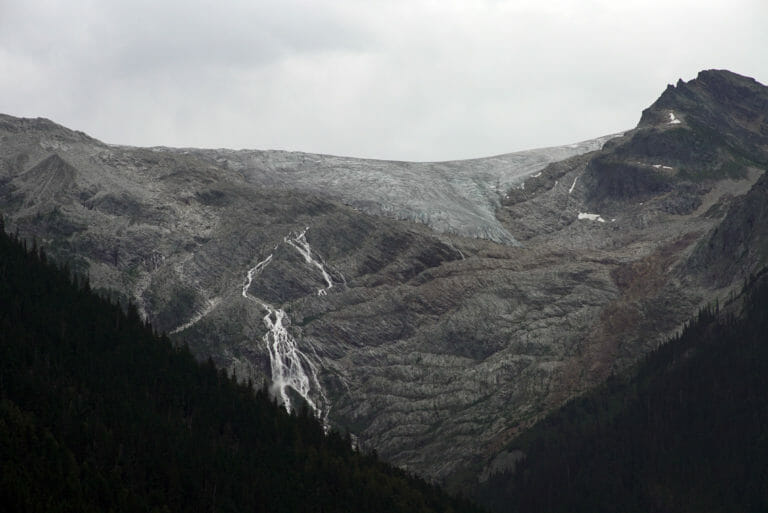
We check in to the hotel and move our car to heated underground parking for the night, then get a little lost locating the elevator that will deliver us to the right floor in the right building. I’m excited to reveal the condo unit to Brent, so I rush to open the door first. At this time of night, he just looks relieved; the room is warm, the bed is inviting, and he’s tired.
However, I get excited over the details. It’s like coming back to a trusted friend; the last time I visited I was going out for a day of guided hiking with the resort and savoured the comfort of the hotel and its services — such as delivering my dinner from the Rockford Restaurant when I was too tired to move my legs any further.
This unit faces the Monashees and a wide section of the Columbia River, a view I’m excited to check out in the morning. I walk into the bathroom — bigger than my dining room and kitchen combined back home, and find a complimentary loofah sponge amongst the shampoo and soaps. It comes in handy as I scrub off the day’s hikes.
Clean, refreshed, warm, and eyeing the softness of the bed, I pull on my pjs and wrap myself in covers until morning.
When it arrives, there’s a cloud layer obscuring the Monashees, but as the morning sun rises, so does the layer. I don’t have to wait long to get the full picture. Stepping out onto my eighth floor balcony, I look out in the distance, beyond the rooftops of Revelstoke, to see the sun shining on the glassy surface of the Columbia River.
I stay out here, hopping from one foot to the other to keep the cold from numbing my feet. It’s our last day on this trip, and Revelstoke feels so close to home that I almost feel we’re there. But I want to hang on to all the new experiences we’ve had this past week and do as much as I can today to create new ones before all is wrapped up.
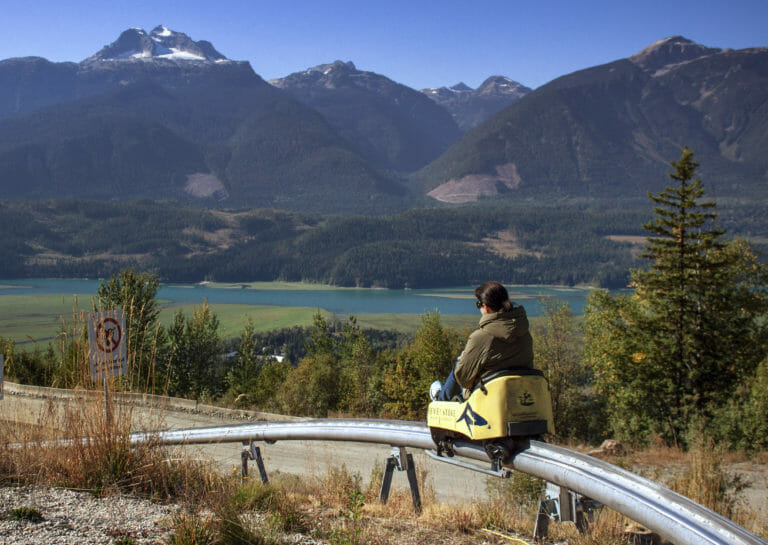
The first activity feels a little childlike — but that suits me just fine. I’m meeting Carly Moran, media relations specialist at Revelstoke Mountain Resort to grab breakfast together before heading down mountain on the resort’s Pipe Mountain Coaster.
We meet at the base of the gondola, just a minute’s walk from my hotel room, and head up to Revelation Lodge, where we fill our plates from the buffet and customize our omelets with the chef standing behind the station.
It’s still cool outside, but the sunshine on the deck is too tempting to pass up in favour of eating inside. The deck, which can seat 120 people, spreads out with more views of the Monashees and Columbia River, and though Carly and I are talking, I have a hard time tearing my eyes away from the mountainscape.
She talks to me about moving here from Toronto, where she loved the arts scene, but longed for the quiet mountain town life. In moving to Revelstoke, she thought she was making a conscious decision to trade in arts and culture for a life without traffic lights and long commutes. But she’s gotten both positives instead.
“I love being here in Revelstoke because there are lots of shows, music every night in the summer, and art installations through events like the Luna Festival,” she says, describing the latter as an event where visiting and local artists create installations that can be discovered through a guided program on different nights of the week.
“I still have the benefits of the big city but without the hassle.”
We finish up breakfast while still talking about Revelstoke, this time about all the hiking and mountain biking that takes place at the resort, and the programs they’re working on for next summer. For now, there’s guided hiking tours that transfer to snowshoeing tours in the winter, and of course, the Pipe Mountain Coaster.
I send my bag and camera down on the gondola where I can pick it back up when I’ve finished my ride. She loads me into the car in front of her and fires up her camera, ready to take a video. “It’s so fun to see the reactions when people go on this their first time,” she says. I confirm with the staff that I can give’r the full steam ahead (no braking required) and not fly off the track, they give me the A-Okay, and off I go.
The coaster flies. I’m still pulling back to engage the brakes around bends, especially when the trees get tight and the drops get steep, but trust kicks in the further along I go.
The track whips around open space then drops back into the trees, revealing then hiding where it leads to next. The pace doesn’t slow until I’m at the very end — where I’ve now stopped any reliance on the brake — and I remember I have a second ticket to ride.
This time, I take the 1.4km track full throttle, dropping 279 metres in elevation over its length without the brake. Oh. My. Carly told me it’s possible to travel up to 42km/h on the coaster and I wonder how near to that speed I might be reaching. Tears are streaming from my eyes and I let out a holler with one of the more precipitous drops in the woods.
Well, that woke me up. Time for a beer.

Brent helps me pack the car and we start out to Mt. Begbie Brewing Company’s new facility and tasting room. After 21 years of craft brewing, they’ve expanded from their downtown Revelstoke location to a place just outside of town with easy access to the Trans Canada Highway.
It looks like a good move: They’ve got a building they’ve designed of their own, lots of room to expand, and are located right next to a heli-lodge, with 10 acres to play.
Once inside, Tracey Larson, co-owner with and wife of Bart Larson, says the move was partially focused on tourism — with this location next to an established heli-lodge — and creating a tasting room, something they couldn’t do at their downtown location.
Our visit coincides with the finishing touches being applied on the aforementioned tasting room, with plans also being finalized for the grand opening celebration. When finished, the tasting room will seat 66 people inside, with a capacity of another 75 on the patio. They plan on including a tapas-style menu in addition to up to 16 taps that will pour beer and possibly other beverages to round out the options.
Tracey leads us from the tasting room and into the production area where she shows off the “toys” that Bart, who holds a Ph.D. in nuclear physics, has acquired or built from scratch over the years, such as the centrifuge, which omits the need for filtering agents and instead filters beer using a spinning method that separates heavier debris from the liquid.
She describes her husband as very skilled, highly technical, and always looking for the next piece of equipment that will help improve quality. He’s also a DIY’er, which is evident when we reach the cold room. Here, Tracey shows us the different sized tanks they acquired — or that he modified — to accommodate growth as the brewery grew over the years. In the latter case, Tracey explains that Bart would “stretch” the metal of the tanks by cutting them in two and rolling out metal, then fitting the pieces together to create a tank size that fit their need.
His DIY method worked; the proof is in the tanks that stand proud (and tall) in front of us.
We circle back to the tasting room, where natural light floods the space. The three of us take a seat in the unfinished space and I imagine it on opening day, the plans she’s shared with me put into action. She talks about how far the industry has come since she first started more than two decades ago, a time when she recalls only 15 breweries in the entire BC province being in operation.
In a way, Tracey was a pioneer in the BC industry, and perhaps for the larger brewing industry as well.
“As one of the first beer reps, I had to prove and earn respect,” she says of her early days promoting Mt. Begbie as a woman. “So many people didn’t think I knew what I was talking about; it was a hard go in those days.” She compares it to today, when she sees a huge shift in the industry, with women owning bars and breweries and having equal footing with the men.
The brewery also pays homage to history that goes even further back, back to the days before skiing was an industry and the majority of townspeople here still earned their living from the land.
“Revelstoke has a long-standing history of brewing that dates back to the 1800s,” says Tracey. “We decided to acknowledge our brewing forefathers in our ‘Heritage Series’ using their styles but with a Mt. Begbie take.”
The nod to local history follows in the labeling on their core products, too, with each featuring a historic location in town and drawing on icons in Revelstoke to which locals can relate.
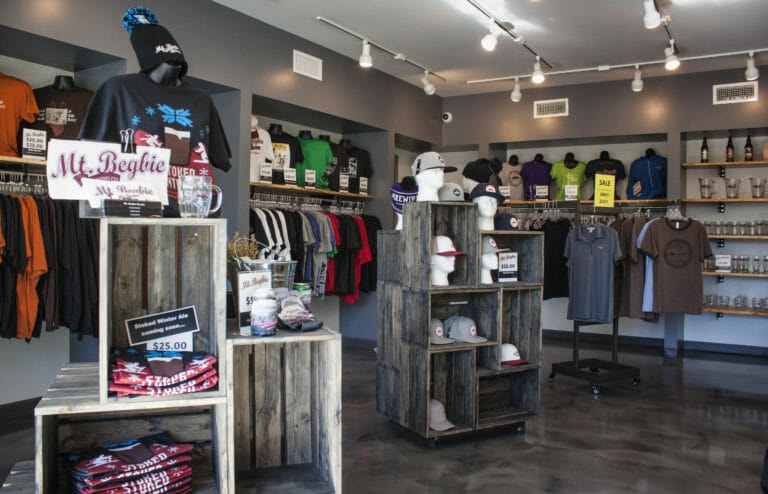
But the future is exciting for Tracey. The new expansion will help them keep a focus on production and packaged product while still drawing in the community spirit on site and attracting newcomers to Revelstoke’s craft beer. She’s looking forward to deepening the relationships they’ve built with businesses in town, and co-creating a menu with a local chef that will pair Mt. Begbie beer with fresh, local ingredient-infused dishes for the tasting room.
And, she reminds us as she packs up bottles of brew to take home, even after 11 months of seeing the mechanical birds take flight, she’s still excited to be located next to the heli-lodge. “We’re like kids seeing the helis taking off.”
I don’t think that will get old any time soon.
Mt. Begbie Brewing Company Beer Picks
Brave Liver: ABV 5.5% • IBU 14
This full-bodied, winter seasonal scotch ale tastes of roasted malts with a caramel finish. Easy drinking, it makes a choice for a dessert beer.
Revy Pils: ABV 5% • IBU 25
Part of Mt. Begbie’s “Heritage Series,” this Czech Pilsner is a solid interpretation of what it’s supposed to be. The bitterness grows on the back of the tongue long after the sip is through. Easy to drink, Brent, a mountain biker, says it’s the kind of beer he’d drink in the shower after a grueling bike ride.
Nasty Habit IPA: ABV 6% • IBU 41
This IPA is like biting into a spruce tip and getting a fruity finish. With the bitterness tapering off into a lingering flavour rather than vice versa, this IPA is perfect for those who are just getting into the style.

Brent and I return to town for dinner at The Village Idiot Bar & Grill, a Revelstoke hangout that a local introduced me to during a previous visit. It’s known for its funky decor and giant pizzas, and I enjoy it because it’s decked out in repurposed vintage skis and snowboards.
Think of it like your neighbourhood dive bar, but way cooler because everyone here is just getting back from mountain biking or skiing. Accordingly, television screens loop ski and bike movies, catering to the clientele.
Today, it’s a bike movie, and I order the “WE FOUND NEMO!” fish tacos while Brent grabs his staple, a burger. Similar to craft beer, I’ve found that local restaurants in our Kootenay towns pay special attention to flavour; the Village Idiot has never disappointed in this arena.
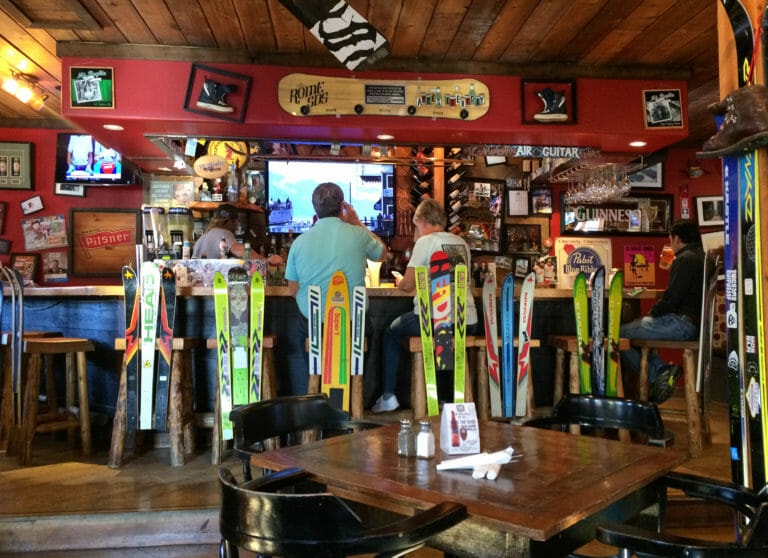
I’m filled to the brim by the time the movie is over and I’ve cleaned my plate. We head out to spend our final moments in Revelstoke outdoors, stretching our legs before the long drive — and ferry ride — home. Along the Illecillewaet River, we follow the Greenbelt Trails until we find a clearing leading to the rocky banks. The sun is getting low over the Monashees and I feel the warm autumn air touch my skin as I strip off my jacket and walk across the rocks to touch my toes into the water, milky blue in colour from the rock flour silt.
The atmosphere is calm: no deadlines, no rush, no ringing of phones — just the way a Kootenay road trip should be. A ton of happy memories rush forward from the past week and I stay in that sunny moment until Brent rejoins me beside the river bank.
The sun sinks lower, I pull my jacket back on, and we walk back to the car for the last time on our trip.
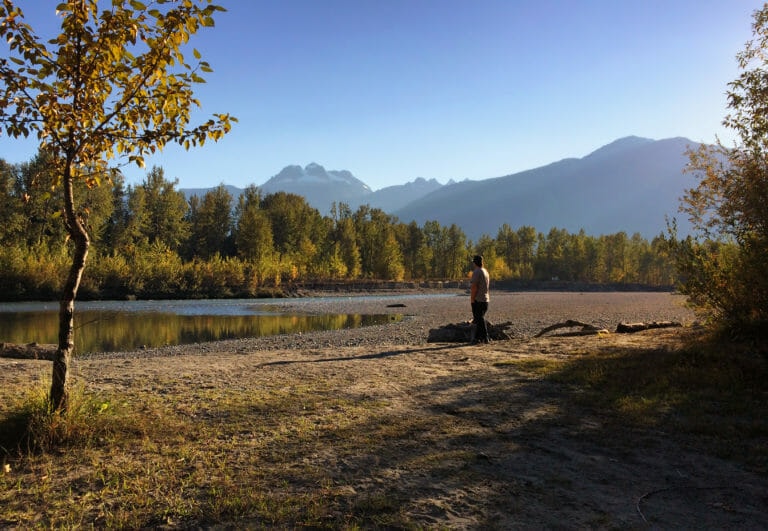
Produced In Collaboration With

The Birthplace of Adventure
In the southeast corner of British Columbia, the jagged peaks of the Rockies rise in parallel with those of the Purcell, Selkirk and Monashee ranges. In between are valleys, rivers and lakes that have enabled human existence for thousands of years. With incomparable scenic beauty around every turn, this is British Columbia’s Mountain Playground.